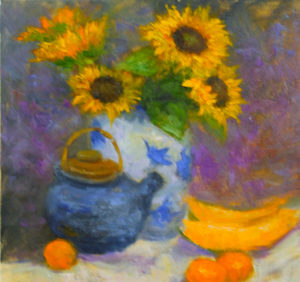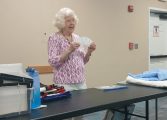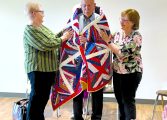By Page H. Gifford, Correspondent
Russian artist Julia Lesnichy spoke about her passion for plein air painting with the Fluvanna Art Association Sept. 21. An award-winning plein air impressionist painter, she is originally from St. Petersburg, Russia. She majored in linguistics, German and English but took private art classes in drawing and painting in Moscow in 1998 and began her art career.
A year later she moved to Charlottesville with her husband who was studying law at the University of Virginia and took classes in pastels and oils. Though her pastel work is flawless, for practical reasons she favors oils.
 “Pastels do not sell as well as oils and most galleries will not sell pastels,” she said. “I took classes with nationally recognized plein air artist and instructor Lois Griffel and this changed my life.” She then returned to Russia after attending the Cape Cod School of Art – the first outdoor school of figure painting in America, started by Charles Webster Hawthorne in Provincetown, Mass., in 1896. By 1915, it grew into one of the largest art colonies, attracting well-known artists including Norman Rockwell, Max Bohm and Childe Hassam.
“Pastels do not sell as well as oils and most galleries will not sell pastels,” she said. “I took classes with nationally recognized plein air artist and instructor Lois Griffel and this changed my life.” She then returned to Russia after attending the Cape Cod School of Art – the first outdoor school of figure painting in America, started by Charles Webster Hawthorne in Provincetown, Mass., in 1896. By 1915, it grew into one of the largest art colonies, attracting well-known artists including Norman Rockwell, Max Bohm and Childe Hassam.
She returned to the U.S. to live in 2010 and became a full-time artist. Her work has been featured in many art publications and galleries around Virginia and other areas of the U.S. Her work is bright and beautiful with strong color.
“I love color,” she said. Influenced by impressionistic artists like Monet and Hassam, her paintings are serene and have a calming effect. “I am inspired by fast-changing light and color in nature.” If the light begins to change while she is outside working on a piece, she starts another painting of the same scene.
She showed the members her process and in the span of an hour and a half, she completed what most felt was a finished work. It often takes her two to three hours to complete 85 percent of the painting before adding detail. Beginning with her sketch, she pointed out several key elements in creating a still life.
“Always locate the center of interest in a still life or a landscape. Always think before you paint; plan your values and colors,” Lesnichy said as she scumbled color onto the canvas, blending and sweeping colors into each other.
In designing her still life, she creates diagonals to show movement and stacks objects to show perspective. She stressed not to center large objects.
“It’s a lot of work just arranging flowers in a still life,” she said. “The rule is not to have repetition but to have as much diversity as possible.” Her theory is that the arrangement should reflect reality in nature, and no two flowers are alike. When it comes to still life, Lesnichy is influenced by Dutch masters and contemporary still life artists like Jeff Legg and Daniel Keys for their arrangements and compositions.
“I engage in a very loose creative process, following basic rules,” she said. Unlike Legg and Keys, she is not a realist, so her painting is not representational of the object itself but instead shows her view of what she sees. As she paints, she achieves balance through what begins as a haphazard method that gradually takes form. To keep her style loose she uses large brushes and a palette knife and later she will use a smaller brush for details.
“For landscapes, plein air, getting outside is the best,” Lesnichy said. “Try not to paint from photographs. Learn from the real world. If you do paint anything from photographs, darken in highlights – they tend to be too light.” She continued a series of quick strokes with her brush, adding that using oils allows her more experimentation and that she was taught to ignore the edges of her subject but focus in on the negative space and values.
“Be conscious of light and shadows and reflective light. Shadows have more reflective light than you think,” she said.
High intensity color is dominant in Lesnichy’s work. She takes command of her palette and knows what works and what doesn’t.
“I like high chroma paintings. But learn to balance color. Many artists are not sure about color and stick with predominately neutral colors. Don’t be afraid of color,” she said. “Everything is about balance.”
To see more of Julia Lesnichy’s work, visit https://www.julialesnichyart.com.




